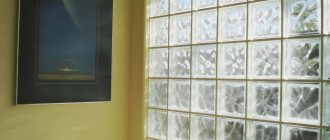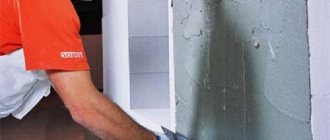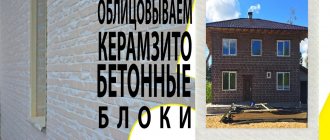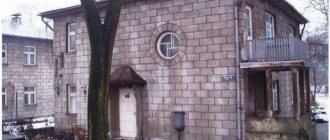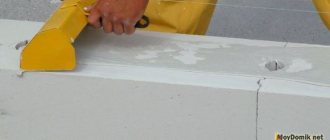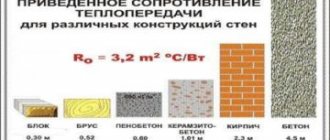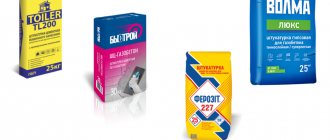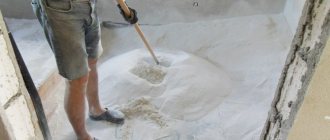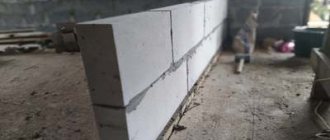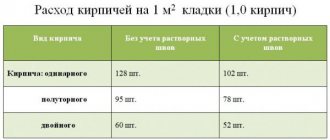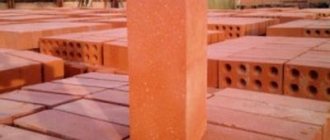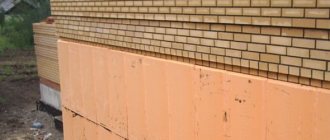Is it possible to build a house from expanded clay concrete blocks?
Yes, the strength of expanded clay concrete blocks
allows you to build walls up to three floors. Expanded clay concrete blocks are a good alternative to bricks at a lower construction cost.
Interesting materials:
How to create a new database in Access? How to create a new geolocation on Instagram? How to create a new geolocation on Instagram? How to create a new pair with Apple Watch manually? How to create a new page in Libra Office? How to create a new page in open office? How to create a new page in wordpad? How to create a new row in Excel? How to create a new account on Xbox? How to create a new ID?
Number of expanded clay blocks in 1 cubic meter
The scope of application of expanded clay concrete includes low-rise and frame-monolithic construction; the characteristics of the products are suitable for the construction of garages, cottages, bathhouses, extensions, partitions and load-bearing walls of 1-3 storey residential buildings. Products are sold on pallets; to determine the required quantity, it is important to know how many expanded clay concrete blocks are in a cube or square meter of masonry. The main reference point is the value specified by the manufacturer; if this is not available, a simple calculation algorithm is used. Calculations are carried out at the design stage, after finding the thickness of building structures.
Calculation of the number of expanded clay blocks in 1 cube, taking into account their sizes
The initial data for the calculation are the dimensions; knowing them, it is easy to find the volume of one piece. According to GOST 6133-99, for wall blocks they are 490x290x240 mm, but in practice, most manufacturers produce products with other dimensions. Thus, for laying load-bearing structures, slotted or solid products 390×190×190 mm are most often used, and partitions - 390×90×190. In the first case, the volume of one piece is 0.014 m3, respectively, 1 cubic meter includes 71.43 pieces.
The laying of expanded clay concrete blocks is carried out on a cement-sand mortar or adhesive mixture, in the first option the thickness of the joints reaches 20 mm, in the second it varies within 5. Taking this into account, there will be several fewer of them in 1 cube of the structure being built, the calculated dimensions are increased by an average value – 10 mm. Accordingly, the volume of one wall expanded clay block (400×200×200 mm) increases to 0.016 m3. For 1 cubic meter of masonry it will take at least 1/0.008 = 62.5 pieces. To avoid errors when purchasing, the resulting value is usually rounded up.
You may also be interested in the article Determining the number of bricks on one pallet.
When using special glue, it is easier to find how many blocks are in one cube; in this case, the thickness of the seam is neglected. But this method is only suitable for products with high geometric dimensional accuracy (which are rare), otherwise the consumption of the connecting solution will increase unjustifiably. The approximate number of blocks for different purposes per 1 cubic meter is given in the table:
| Dimensions, mm | 390×90×190 | 390×120×190 | 390×190×190 |
| Total number for tight fit | 150 | 112,5 | 72 |
| Total blocks in masonry | 139 | 104,5 | 62,5 |
To eliminate errors, the dimensions specified by the manufacturer should be checked; for this purpose, several random blocks in the batch are measured with a tape measure. The given algorithm is intended to determine the number of products in a continuous masonry. It is more difficult to calculate how many of them will go on a wall with openings; usually the project is adjusted to the size of expanded clay blocks. It is better to buy them with a 5% reserve; the calculation results are rounded up.
Characteristics of expanded clay blocks
The standard marking, in addition to the letter “K” (artificial stone), includes its functional purpose: S - wall, P - partition, L - front, R - ordinary. The fourth and fifth letters indicate the place of the product in the masonry, then its length and grades of strength, frost resistance and density are indicated. The main parameters include:
- Density - depending on the fraction and type of filler, varies between 500-1800 kg/m3.
- Thermal conductivity coefficient, directly related to the previous characteristic. The operating range is from 0.18 to 0.9 W/m °C; expanded clay concrete blocks provide good energy saving for the building.
- Strength ranges from 35-250 kg/cm2, for some structural grades it reaches 500.
- Frost resistance – up to 75 cycles.
- The fire safety class of expanded clay blocks is A1.
- Vapor permeability coefficient - depends on the density brand, from 0.256 at 600 kg/m3 to 0.094 mg/m·h·Pa for structural products.
You will find a more detailed description in the review of the technical parameters of expanded clay blocks.
The material is non-shrinking, environmentally friendly and durable; the service life of expanded clay blocks reaches 50-60 years. In addition to the above, its advantages include reasonable cost (on average 2,600 rubles per cubic meter), simplicity and convenience of masonry, versatility (suitable both for the construction of load-bearing structures and as additional thermal insulation for a house), acceptable adhesion and compatibility with finishing compounds. When choosing, it is important to check the composition of the material; the presence of a document confirming the characteristics declared by the manufacturer is mandatory.
Cost of expanded clay blocks of different types
| Product type | Dimensions, mm | Weight, kg | Strength grade | Frost resistance | Total blocks in 1 m3, pcs (excluding masonry mortar) | Price for 1 piece, rubles |
| Septal three-slit | 390×80×190 | 7,5 | M50 | F50 | 169 | 28 |
| 390×90×190 | 9,4 | 150 | 29 | |||
| Septal corpulent | 11,3 | 33 | ||||
| Expanded clay concrete solid block | 390×190×190 | 23,8 | M100 | 71 | 66 | |
| 380×250×140 | 22,6 | 75,18 | 60 | |||
| Wall hollow expanded clay block | 390×190×190 | 13 | M50 | 71 | 49 | |
| Same, 11-slot | 18,2 | M75 | 55 | |||
| Same, 18-slot | 380×250×140 | 16,5 | 75,18 | 59 |
Density
The density of a material, as stated above, is directly related to its weight and strength. The connection is this: the denser the aerated concrete, the higher its strength and weight, and also the lower its heat-saving abilities. Therefore, the choice for the master is always difficult: either choose a durable and dense, heavy material (which will complicate installation and make the house less warm), or build from a loose material of low strength, which will be light and provide the best thermal insulation and sound insulation properties.
Aerated concrete blocks are divided into grades, which indicate not just numbers, but density, the number of kilograms of material per cubic meter. D200 brand blocks have a density of 200 kg/m2 - that is, their weight is 200 kilograms per cubic meter.
The density of aerated concrete varies by the volume of the gas-forming agent in the composition of the material. The blocks are made from a mixture of cement, water, sand and aluminum powder. The volume of bubbles in the composition can vary between 20-90%. Air bubbles in the structure directly affect the density and strength - the more of them, the less dense and durable the material, but the higher the heat saving rate.
For the construction of residential buildings with 2-3 floors, aerated concrete with a density of 400-500 kilograms per cubic meter is most often chosen. This is the most optimal ratio of characteristics.
Price of aerated blocks with quadrature calculation
Each customer wants to know in advance the amount he will have to pay when purchasing the material. To do this, you need to decide not only on the size of the blocks, but also on their manufacturer and the offered price. For example, let’s calculate a gas block for 100 sq.m of walls.
Let's say you decide to take blocks 250*600*375 mm at a price of 3,500 rubles per cubic meter. Knowing the square footage of the wall, it needs to be multiplied by the thickness of the masonry (in this case it is 375 mm), and you will get the cubic size of the walls. 100 m2*0.375 m =37.5 m3. Multiply by the price, we get 37.5 m3*3500 rub.=131250 rub./m3
Production technology
Expanded clay concrete blocks are manufactured at many enterprises. As follows from expert reviews, materials from Aleksin, Minskzhelezobeton, Vinziley, Tuymazy, Shakhovskaya, Shaksha are popular. Expanded clay concrete blocks of German quality are especially valued.
The technological process for manufacturing the material at each enterprise is different. Various proportions of raw materials are used; some manufacturers use plasticizer additives that affect the final cost. Because of this, the mixture gains better mobility, fills forms better, leaving almost no empty spaces. Experienced specialists add liquid soap or adhesive instead of plasticizers, increasing plasticity and reducing the amount of water.
The production process can be divided into three main stages:
- An initial mixture is prepared, consisting of expanded clay sand, clean water, cement material and fillers. Cement in this case is a universal binder. The proportions may differ - the strength indicator increases depending on the amount of cement, but at the same time the weight of the block changes and its heat resistance decreases. To make 100 kg of mortar, you will need 54.5 kg of expanded clay stone, 27.2 kg of washed sand, 9.21 kg of cement material, 9.09 kg of clean water. Initially, to prepare a standard mixture, water is poured into a concrete mixer, expanded clay, cement are added, and then sand is added. Everything is mixed for two minutes. To make one block, the size of which is 400 x 200 x 200 mm, you will need at least 11 - 12 kg of solution. It turns out that from the prepared batch you will get 9 - 10 stones.
- It's time for molding. It is performed on vibrating machines; plates made of stainless steel material are inserted into special recesses of the required shape, onto which a mixture of expanded clay concrete is poured. After this, distribution and compaction begin due to vibration, excess raw materials are removed, and the mold is sent for drying.
- This is already the third stage. The blocks are dried for at least two days, after which the plates are removed, and the process continues in the open air and lasts up to one and a half weeks.
It is easy to prepare expanded clay concrete blocks yourself; the technological process does not cause any difficulties. But if you study the reviews of home owners, it turns out that it is more profitable to purchase ready-made material than to manufacture it on site.
How to choose the best building material for your home
Which blocks are best for building a house? Sturdy, durable and warm
People usually think about a house made from building blocks because it is faster than using traditional building materials. Speed is speed, but quality characteristics are no less important. And to choose them correctly, here's what you need to know.
The cost of blocks for building a house also plays a significant role. The cheapest are polystyrene concrete and expanded clay concrete
As you can see, the list is considerable, but this information is necessary. Without them, there is no point in deciding which blocks are best for building a house. You simply won't have any criteria to choose from.
Construction methods
Vertical partitions inside a building can be erected using two methods:
- monolithic concreting in specially designed formwork;
- masonry using pre-made expanded clay concrete partition blocks.
The base for the partition, if it is a concrete floor in a new building, must be leveled in a horizontal plane using a cement-sand mortar screed. If this is an old beam-type floor, the area under the future partition should be dismantled until the beams, which can be wooden or metal, are exposed. In this case, it is better to place the partition along the beam. If a perpendicular arrangement is required, a redistribution log made of wooden beams, metal channel or I-beam must be installed under the partition, laid perpendicular to the load-bearing floor beams.
Monolithic concreting
For monolithic concreting the following formwork can be used:
- Inventory: - metal; - polymer; - made of specially treated plywood.
- Homemade: - wooden-panel.
To ensure the workability of the concrete mixture, it is better to erect monolithic partitions before the construction of the upper floor begins. The concrete mixture should be designed based on the class of set concrete not lower than B7.5 (M100). Reinforcement of a monolithic partition should be performed, depending on the thickness, with one or two meshes of rods d = 8...10 mm, with cells 100 x 100 or 100 x 150 mm. In order for a protective layer of concrete to form, the reinforcement must be separated from the outer surface of the partition by a distance of at least 20 mm. To connect reinforcement elements, soft knitting wire with a diameter of 1...1.5 mm is used.
When manufacturing reinforcing mesh, it is prohibited to use electric arc and gas welding to connect longitudinal and transverse rods, since in these places the metal will anneal and lose its tensile strength.
To make your own formwork, you can use unedged slab boards with a thickness of 25...30 mm and a block of 50 x 40 mm. Before use, the surface of the formwork should be sheathed with roofing felt or wrapped with thick plastic film.
If necessary, doorways and openings for laying utilities must be cut out in the formwork before concreting. During work, it is recommended to use an electric concrete mixer, as well as a submersible vibrator with a flexible shaft.
Laying expanded clay concrete blocks
Expanded clay concrete partition blocks, the sizes of which are standard, the sizes used in most cases can be manufactured both in the factory and directly on the construction site. For this purpose, cassette formwork and a semi-dry method of pressing expanded clay concrete mixture are used. The blocks can be solid and have internal voids, which reduce weight and reduce the labor intensity of masonry. The most commonly used sizes of piece elements for laying partitions made of expanded clay concrete blocks:
- Expanded clay concrete partition block 390x90x188 - suitable for lightweight partitions, most often used in rooms with low thermal insulation requirements. The concrete class of such blocks is usually not lower than B5 or the “old way” M50, volumetric weight from 1000 kg/m3.
- 190x188x390 is the most common expanded clay partition block produced with dimensions suitable for constructing most partitions. When laying main walls, it can be used in 1.5 or 2 blocks. Concrete class starts from B5 (M100), volumetric weight – from 1200 kg/m3.
- 230x188x390 - used for partitions with improved sound insulation and heat protection properties, as well as when the height of the partition is more than 3.5 m. Blocks with the same dimensions in the southern regions are also used for load-bearing (main) walls in the case of using light interfloor ceilings on wooden or metal beams .
The bed of expanded clay concrete blocks can be smooth, or it can have a ridge at the top and a groove at the bottom. When laying, the ridge fits into the groove and “automatic” alignment of the vertical surface of the partition occurs. In this case, the mason can only align the horizontal and vertical positions of the several lower rows using the cord and level.
In rare (exclusive) cases, blocks can be made with other, individual sizes and configurations - angular, in the form of beams and lintels, curved (for example, arched).
When forming a partition, the blocks are laid in rows on cement-sand or cement-lime mortar. The thickness of the seam should be no more than 10 mm. Every three rows, the masonry of expanded clay concrete blocks is reinforced with a mesh of rods d = 4...6 mm with cells 50 x 50 mm.
The masonry solution should be thoroughly mixed until it is completely homogeneous.
Laying partitions from expanded clay concrete blocks will require the use of such common tools as:
- plumb line;
- bubble level;
- cord or twine for marking;
- water level;
- metal rail-rule;
- drill;
- trowel;
- solution container;
- mixing attachment for preparing the solution.
Expanded clay concrete design
Both for monolithic concreting and for the manufacture of blocks, strict implementation of the technology for preparing expanded clay concrete is required. Only in this case it is possible to obtain a material with balanced properties of strength, volumetric weight, noise insulation and heat protection. Typically, the concrete recipe is specified in the detailed design of the building. For independent calculations, you can use online calculators or special reference books.
The starting materials for the production of expanded clay concrete are cement of a grade not lower than M400, washed river quartz sand, as well as expanded clay with a fraction (grain diameter) of 10...20 mm.
A large number of owners of premises in which partitions made of expanded clay concrete blocks are used, reviews left by them on a variety of thematic resources, allowed architects, designers and builders to draw conclusions that, due to their properties such as ease of manufacture and operation, strength, durability, cost, etc. The physical and technical parameters of these structures are unparalleled. Some identified disadvantages are completely compensated by advantages.
Flaws
- Compared to heavy concrete, expanded clay is less durable, therefore its use for foundations is possible only with low-rise construction and careful calculations.
- When constructing high-rise buildings, high-density blocks are required, which increases the load on the foundation and requires a more powerful structure, which can increase the cost of the project.
- It happens that expanded clay blocks have non-ideal dimensions due to their structure, so you have to be especially careful when laying them. But if deviations are within the limits allowed by GOST, no problems arise.
What factors can influence size deviation
Even in the conditions of a well-functioning production process, it is possible that the dimensions of the finished product may deviate from the dimensions prescribed by regulatory documentation. Typical factors influencing the occurrence of marriage are:
1. Physical wear of the walls of the matrix, trays, and pressing equipment. Fresh expanded clay concrete mixture has high abrasive properties. Even high-quality steel, when in contact with it, can wear out by 3-4 mm in 1-2 years, which invariably affects the increase in the dimensions of the finished product. The use of plywood leads to an even faster disruption of the geometry of the forms. Sometimes, under the regular influence of a hydraulic press, the vibrating platform is pushed through.
Mold for expanded clay concrete blocks.
2. Unjustified interference with the design structure of the matrix. Some manufacturers, in an effort to make their products lighter, increase the thickness of the void formers. An increase in the proportion of voids, in addition to a violation of the geometry, also leads to a noticeable deterioration in the strength characteristics of such blocks.
Mold for hollow expanded clay concrete blocks.
Weight
The weight of an aerated block, just like its size, can be very different and depends not only on the dimensions, but also on the density. The higher the density of concrete, the more it weighs.
Types of aerated concrete by weight and density:
- The lightest
– they have many pores, the density is minimal, the material is usually used as insulation; it is not suitable for laying walls due to its low strength. The mass of such blocks is 200-500 kilograms per cubic meter.
- Heavy aerated blocks
- the most common option. A cubic meter weighs up to 500-900 kilograms. These blocks are ideal for constructing walls of low-rise buildings.
- Extra-heavy gas blocks
– 900-1200 kilograms per cubic meter. Such blocks are used in high-rise construction; they are considered the most durable and dense, but also the heaviest.
In order not to make a mistake when choosing a material, just look at its brand - it corresponds to the density, the number of kilograms per cubic meter. Thus, the brand of aerated block D400 indicates that the density of the material is 400 kg/m3, D600 – 600 kg/m3, etc.
Manufacturers
Many domestic factories are engaged in the production of various types of expanded clay blocks. Let's list the most popular ones.
- Kstovo expanded clay concrete plant. Produces modules using expanded clay fraction 5-10 mm. The material is manufactured on the Rifey-Polyus automated line. The company produces solid and four-slot blocks.
- "Teplostroy IM" The company was founded in Cheboksary. It has been producing expanded clay concrete modules since 2005. Productivity is 1500 blocks per day. For the production of building materials, the company purchases expanded clay 10-20 mm, which is subsequently crushed into smaller fractions - 5-7 mm.
- Ishleysky building materials plant. One of the first producers of expanded clay blocks in Chuvashia. The company was founded in 2000. In the first years of operation, modules were manufactured using homemade equipment. Today, the Rifey-Universal automatic line is used for their production. The daily production capacity of the plant is 1200 products.
- Bloks 21. The company produces hollow expanded clay blocks in Novocheboksarsk. Maximum productivity reaches 1500 products per day. Bloks 21 company offers its customers delivery and unloading.
- "EcoBlock". Manufacturer of large format blocks. The plant is located on the territory of Naberezhnye Chelny. Offers modules of non-standard sizes, as well as decorative solutions for cladding work. The company produces sand-free blocks. Expanded clay, cement and water are used to prepare the solution.
Popular manufacturers of block expanded clay materials also include PF Veles, GK Mercury, and Forward.
Application area
[ads-pc-1] [ads-mob-3]
This material is universal - its strength and thermal conductivity allow it to be used for the construction of objects for any purpose. For example, the foundation can be laid out from massive reinforced elements that can withstand heavy loads. The walls are built from special blocks designed to create an insulating layer, and their use is due only to the difference in the composition of the solution and the complexity of the design: load-bearing and supporting expanded clay bricks have increased mass and increased density, and insulating elements are characterized by increased porosity and low weight.
Parameters of expanded clay brick
Recipe specifics
The basis of the expanded clay block is a cement-sand composition and expanded clay, which has a spherical shape. The aggregate is obtained from clay fired at a high temperature. The concentration of expanded clay in the mass determines how much the expanded clay concrete block weighs and what its strength is.
The strength characteristics of expanded clay concrete products and the ability to conduct heat are connected by a certain relationship. As the strength of structures built from expanded clay concrete increases, the coolness in the room increases. These parameters are influenced by the size of expanded clay, the volume of air cavities in the mass, and the recipe.
The array consists of the following ingredients:
- Filler in the form of expanded clay with a particle size of up to 1 centimeter.
- Fine sand.
- Portland cement.
- Water.
The ratio of expanded clay, cement, water and sand is expressed as 6:1:1:3. Special tables developed by expanded clay concrete manufacturers indicate how much a certain type of block weighs. Before purchasing the necessary material, it is advisable to familiarize yourself with the range and characteristics of products offered by manufacturers.
In the manufacture of expanded clay blocks, a number of main ingredients are used, including expanded clay, construction sand, cement mixture, and water.
Advantages
- Standardization of sizes and other indicators allows blocks to be laid using the simplest technology, and the porosity of the material ensures good diffusion of the solution into the body of the element.
- Structures made of hollow blocks can be reinforced with reinforcement. To do this, reinforcement (rods, rods, metal corners) is inserted into the holes in the body of the product, taking on the properties of a reinforcing frame.
- Sufficiently large dimensions of the products allow you to save on mortar and reduce labor costs during the construction of objects of any complexity and number of floors.
- Low weight determines the type of foundation that can be made lightweight and therefore inexpensive.
- An opportunity to save money without additional insulation.
- “Breathing” walls allow you to maintain an optimal indoor climate without condensation.
- Expanded clay concrete surface can be finished with different building materials, and its structure will ensure reliable adhesion of the layers.
- Solid stones can withstand various hanging objects (cabinets, shelves, appliances).
- Minimal shrinkage will practically not affect the finish and integrity of the structures.
Block characteristics
[ads-pc-1] [ads-mob-3]
